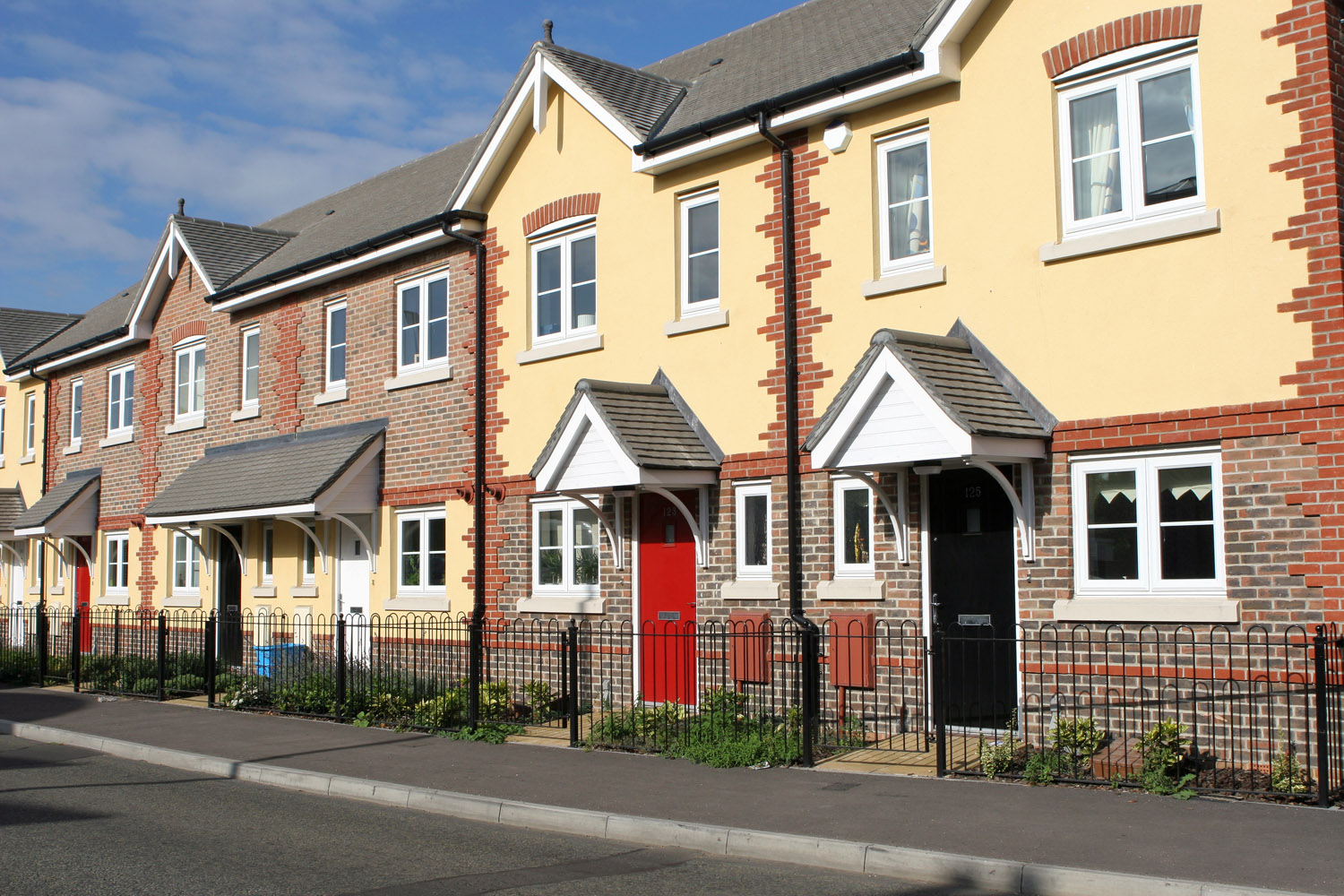 When I worked as a professional economist at HM Treasury and later the Council of Mortgage Lenders (now part of UK Finance), I would regularly brief on the state of the affordability of housing, with a particular focus on the owner-occupied market. That was back in the late 1990s. Fast forward a quarter of a century and I recognise not only how much I have aged but also how deep-rooted and long-standing the affordability problem is.
When I worked as a professional economist at HM Treasury and later the Council of Mortgage Lenders (now part of UK Finance), I would regularly brief on the state of the affordability of housing, with a particular focus on the owner-occupied market. That was back in the late 1990s. Fast forward a quarter of a century and I recognise not only how much I have aged but also how deep-rooted and long-standing the affordability problem is.
It is perhaps not surprising that in her first speech as the new Chancellor of the Exchequer, Rachel Reeves, referenced directly the housing market and the need to address supply-side issues. She has set a target of one and a half million new homes built over the next five years.
It is therefore timely to revisit the trends in house prices across the UK. By applying the distinction between nominal and real values we get a very clear sense of the deteriorating affordability of housing.
Nominal house price patterns
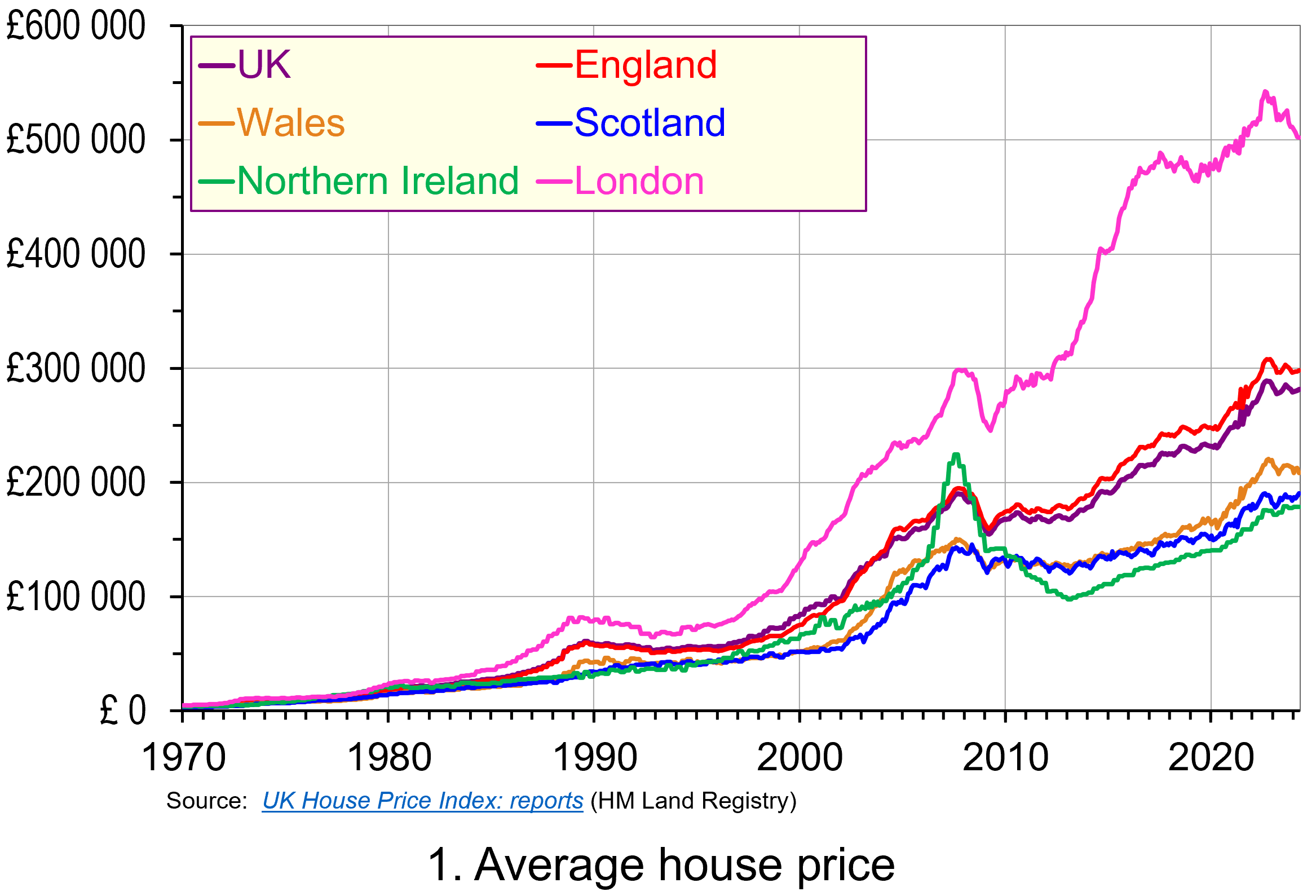 The average UK actual or nominal house price in April 2024 was £281 000. As Chart 1 shows, this masks considerable differences across the UK. In England the average price was £298 000 (105 per cent of the UK average), though this is heavily skewed by London where the average price was £502 000 (178 per cent of the UK average). Meanwhile, in Scotland it was £190 000 (68 per cent of the UK average), in Wales £208 000 (74 per cent of the UK average) and in Northern Ireland it was £178 000 (74 per cent of the UK average). (Click here to download a PowerPoint copy of the chart.)
The average UK actual or nominal house price in April 2024 was £281 000. As Chart 1 shows, this masks considerable differences across the UK. In England the average price was £298 000 (105 per cent of the UK average), though this is heavily skewed by London where the average price was £502 000 (178 per cent of the UK average). Meanwhile, in Scotland it was £190 000 (68 per cent of the UK average), in Wales £208 000 (74 per cent of the UK average) and in Northern Ireland it was £178 000 (74 per cent of the UK average). (Click here to download a PowerPoint copy of the chart.)
A simple comparison of the average house price in April 2024 with January 1970 reveals a 72-fold increase in the UK, an 80-fold increase in England, including a 101-fold increase in London, a 65-fold increase in Wales, a 59-fold increase in Scotland and a 45-fold increase in Northern Ireland. Whilst these figures are sensitive to the particular period over which we choose to measure, there is little doubting that upward long-term trend in house prices.
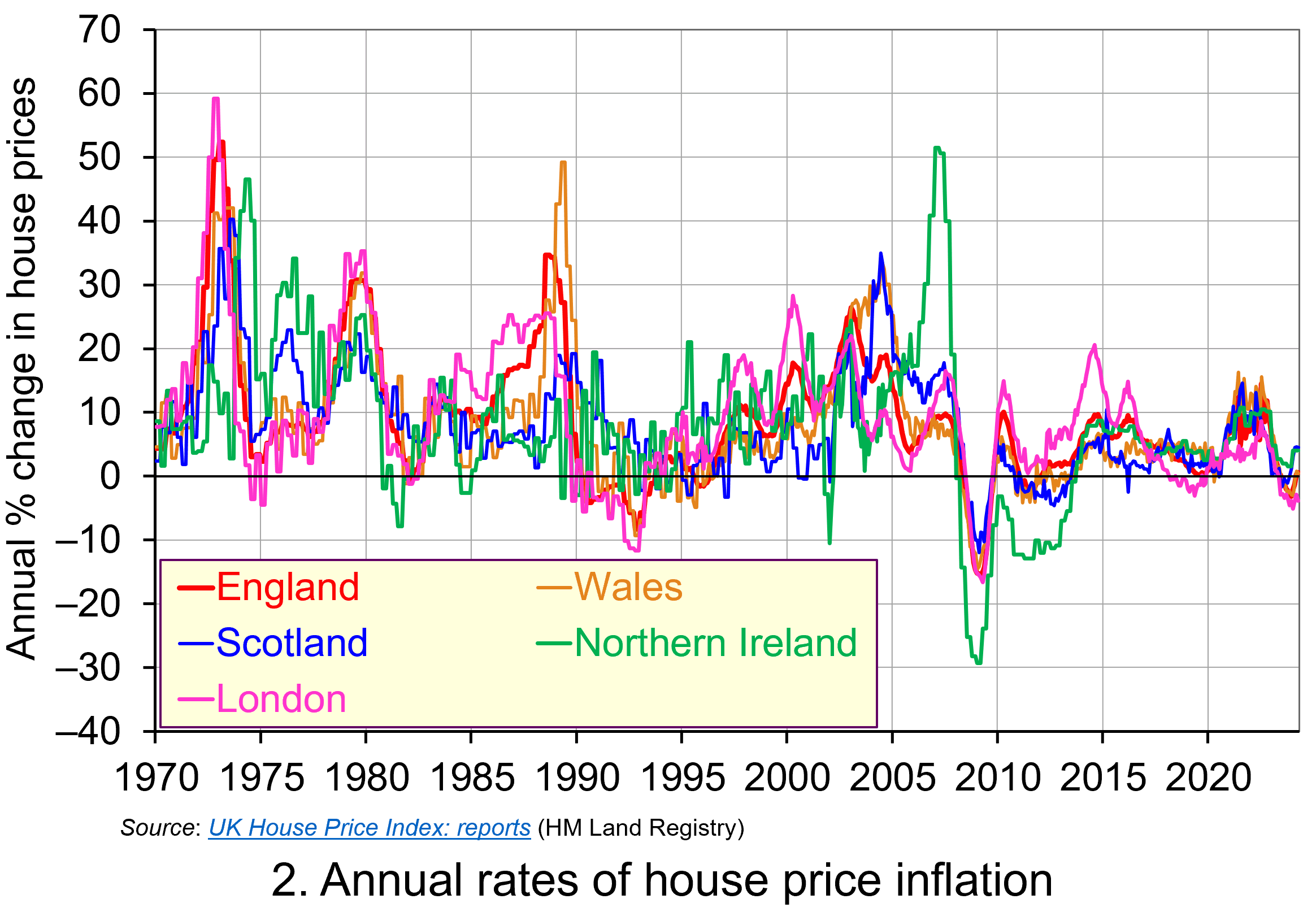 Whilst nominal prices trend upwards over time, the short-term rates of increase are highly volatile. This can be seen from an inspection of Chart 2, which shows the annual rates of increase across the four nations of the UK, as well as for London. This is evidence of frequent imbalances between the flows of property on to the market to sell (instructions to sell) and the number of people looking to buy (instructions to buy). An increase in instructions to buy (housing demand) relative to those to sell (housing supply) puts upward pressure on prices; an increase in the number of instructions to sell (housing supply) relative to those to buy (housing demand) puts downward pressure on prices. (Click here to download a PowerPoint copy of the chart.)
Whilst nominal prices trend upwards over time, the short-term rates of increase are highly volatile. This can be seen from an inspection of Chart 2, which shows the annual rates of increase across the four nations of the UK, as well as for London. This is evidence of frequent imbalances between the flows of property on to the market to sell (instructions to sell) and the number of people looking to buy (instructions to buy). An increase in instructions to buy (housing demand) relative to those to sell (housing supply) puts upward pressure on prices; an increase in the number of instructions to sell (housing supply) relative to those to buy (housing demand) puts downward pressure on prices. (Click here to download a PowerPoint copy of the chart.)
Chart 2 nicely captures the recent slowdown in the housing market. The inflationary shock that began to take hold in 2021 led the Bank of England to raise Bank Rate on 15 occasions – from 0.25 per cent in December 2021 to 5.25 per cent in August 2023 (which remains the rate at the time of writing, but could be cut at the next Bank of England meeting on 1 August 2024). Higher Bank Rate has pushed up mortgage rates, which has contributed to an easing of housing demand. Demand has also been dampened by weak growth in the economy, higher costs of living and fragile consumer confidence. The result has been a sharp fall in the rate of house price inflation, with many parts of the UK experiencing house price deflation. As the chart shows, the rate of deflation has been particularly pronounced and protracted in London, with house prices in January 2024 falling at an annual rate of 5.1 per cent.
Real house price patterns
Despite the volatility in house prices, such as those of recent times, the longer-term trend in house prices is nonetheless upwards. To understand just how rapidly UK house prices have grown over time, we now consider their growth relative to consumer prices. This allows us to analyse the degree to which there has been an increase in real house prices.
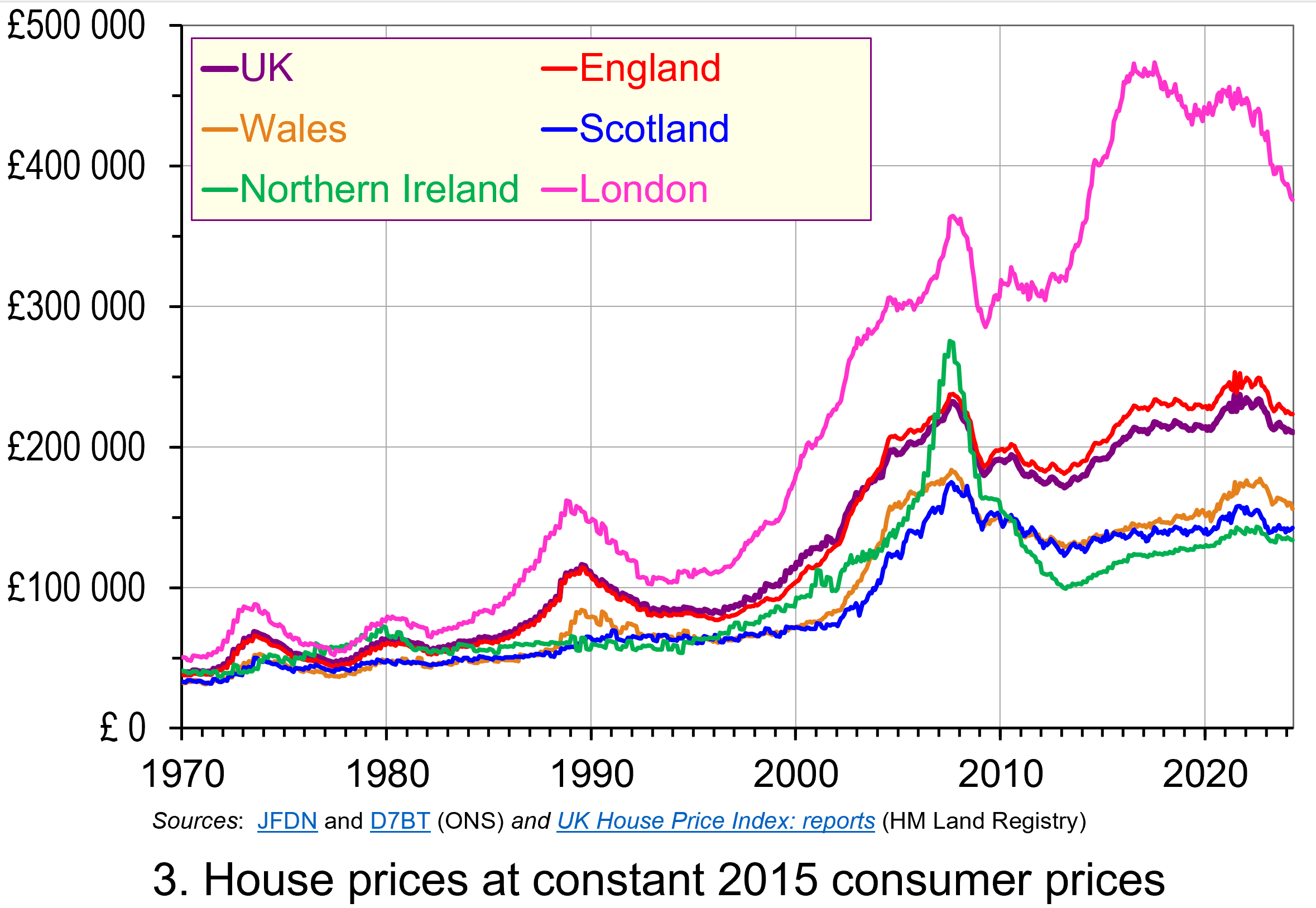 To calculate real or inflation-adjusted house prices, we deflate nominal house prices by the Consumer Prices Index (CPI). Chart 3 shows the resulting real house prices series across the UK as if consumer prices were fixed at 2015 levels.
To calculate real or inflation-adjusted house prices, we deflate nominal house prices by the Consumer Prices Index (CPI). Chart 3 shows the resulting real house prices series across the UK as if consumer prices were fixed at 2015 levels.
The key message here is that over the longer-term we cannot fully explain the growth in actual (nominal) house prices by the growth in consumer prices. Rather, we see real increases in house prices. Inflation-adjusted UK house prices were 5.3 times higher in April 2024 compared to January 1970. For England the figure was 5.9 times, Wales 4.8 times, Scotland 4.3 times and for Northern Ireland 3.3 times. In London, inflation-adjusted house prices were 7.4 times higher. (Click here to download a PowerPoint copy of the chart.)
As we saw with nominal house prices, the estimated long-term increase in real house prices is naturally sensitive to the period over which we measure. For example, the average real UK house price in August 2022 was 5.8 times higher than in January 1970, while in London they were 8.7 times higher. But the message is clear – the long-term increase is not merely nominal, reflecting increasing prices generally, but is real, reflecting pressures that are increasing house prices relative to general price levels.
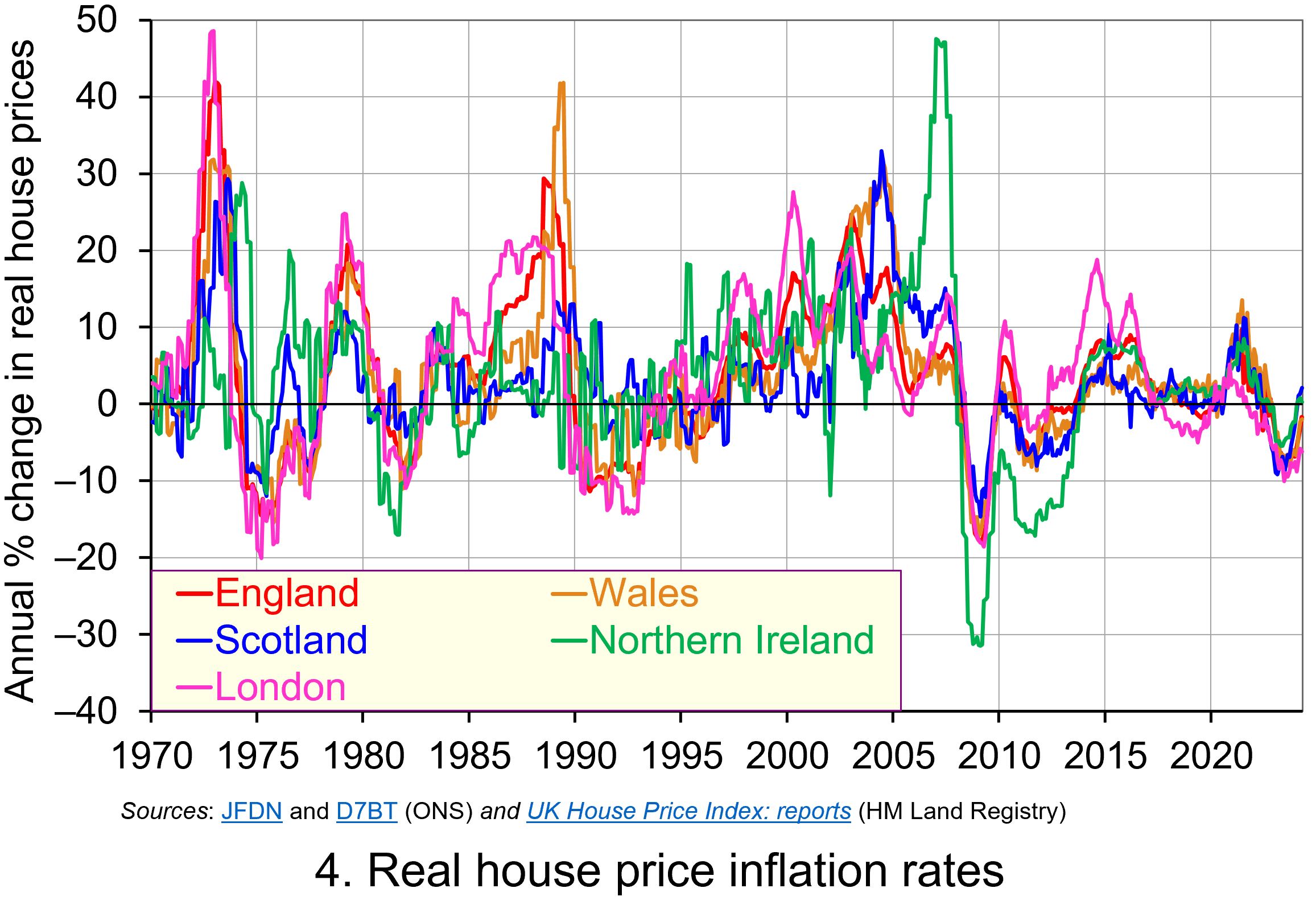 Chart 4 shows how the volatility in house prices continues to be evident when house prices are adjusted for changes in consumer prices. The UK’s annual rate of real house price inflation was as high as 40 per in January 1973; on the other hand, in June 1975 inflation-adjusted house prices were 15 per cent lower than a year earlier. (Click here to download a PowerPoint copy of the chart.)
Chart 4 shows how the volatility in house prices continues to be evident when house prices are adjusted for changes in consumer prices. The UK’s annual rate of real house price inflation was as high as 40 per in January 1973; on the other hand, in June 1975 inflation-adjusted house prices were 15 per cent lower than a year earlier. (Click here to download a PowerPoint copy of the chart.)
Over the period from January 1970 to April 2024, the average annual rate of real house price inflation in the UK was 3.2 per cent. Hence house prices have, on average, grown at an annual rate of consumer price inflation plus 3.2 per cent. For the four nations, real house price inflation has averaged 3.8 per cent in England, 3.4 per cent in Wales, 3.0 per cent in Scotland and 2.9 per cent in Northern Ireland. Further, the average rate of real house price inflation in London since January 1970 has been 4.5 per cent. By contrast, that for the East and West Midlands has been 3.7 and 3.5 per cent respectively. The important point here is that the pace with which inflation-adjusted house prices have risen helps to contextualise the extent of the problem of housing affordability – a problem that only worsens over time when real incomes do not keep pace.
House building
 The newly elected Labour government has made the argument that it needs to prioritise planning reform as an engine for economic growth. While this ambition extends beyond housing, the scale of the supply-side problem facing the housing market can be seen in Chart 5. The chart shows the number of housing completions in the UK since 1950 by type of tenure. (Click here to download a PowerPoint copy of the chart.)
The newly elected Labour government has made the argument that it needs to prioritise planning reform as an engine for economic growth. While this ambition extends beyond housing, the scale of the supply-side problem facing the housing market can be seen in Chart 5. The chart shows the number of housing completions in the UK since 1950 by type of tenure. (Click here to download a PowerPoint copy of the chart.)
The chart shows the extent of the growth in house building in the UK that occurred from the 1950s and into the 1970s. Over these three decades the typical number of new properties completed each year was around 320 000 or 6 per thousand of the population. The peak of house building was in the late 1960s when completions exceeded 400 000 per year or over 7.5 per thousand of the population. It is also noticeable how new local authority housing (‘council houses’) played a much larger role in the overall housing mix.
Since 1980, the average number of housing completions each year has dropped to 191 000 or 3.2 per thousand of the population. If we consider the period since 2000, the number of completions has averaged only 181 000 per year or 2.9 per thousand of the population. While it is important to understand the pressures on housing demand in any assessment of the growth in real house prices, the lack of growth in supply is also a key factor. The fact that less than half the number of properties per thousand people are now being built compared with half a century or so ago is an incredibly stark statistic. It is a major determinant of the deterioration of housing affordability.
However, there are important considerations around the protection of the natural environment that need to be considered too. It will therefore be interesting to see how the reforms to planning develop and what their impact will be on house prices and their affordability.
Articles
- Rachel Reeves requests urgent assessment of spending inheritance
The Guardian, Larry Elliott (8/7/24)
- Reeves to bring back housebuilding targets
BBC News, Faisal Islam and Daniel Thomas (8/7/24)
- UK Chancellor Reeves Vows to Fix Broken Planning System for Housebuilding
Bloomberg UK, Tom Rees, Damian Shepherd, and Joe Mayes (8/7/24)
- What to expect for house prices for the rest of 2024
i News, Callum Mason (10/7/24)
- UK house prices still unaffordable for many people, says Nationwide
The Guardian, Richard Partington (1/7/24)
- House prices still unaffordable for the average earner despite wage rises – Nationwide
Sky News, Sarah Taaffe-Maguire (1/7/24)
- Labour cannot build 1.5m homes without cash for affordable housing, providers say
The Guardian, Jack Simpson (12/7/24)
Statistics
Questions
- Explain the difference between a rise in the rate of house price inflation a rise in the level of house prices.
- Explain the difference between nominal and real house prices.
- If nominal house prices rise can real house price fall? Explain your answer.
- What do you understand by the terms instructions to buy and instructions to sell?
- What factors are likely to affect the levels of instructions to buy and instructions to sell?
- How does the balance between instructions to buy and instructions to sell affect house prices?
- How can we differentiate between different housing markets? Illustrate your answer with examples.
- What metrics could be used to measure the affordability of housing?
- Discuss the argument that the deterioration of housing affordability is the result of market failure.
 UK house prices have been falling in recent months. According to the Nationwide Building Society, average UK house prices in September 2023 were 5.3% lower than in September 2022. This fall reflects the increasing cost of owning a home as mortgage rates have risen. The average standard variable rate mortgage was 3.61% in August 2021, 4.88% in August 2022 and 7.85% in August 2023. A two-year fixed rate mortgage with a 10% deposit had an interest rate of 2.48% in August 2021, 3.93% in August 2022 and 6.59% in August 2023. Thus over two years, mortgage rates have more than doubled. This has made house purchase less affordable and has dampened demand.
UK house prices have been falling in recent months. According to the Nationwide Building Society, average UK house prices in September 2023 were 5.3% lower than in September 2022. This fall reflects the increasing cost of owning a home as mortgage rates have risen. The average standard variable rate mortgage was 3.61% in August 2021, 4.88% in August 2022 and 7.85% in August 2023. A two-year fixed rate mortgage with a 10% deposit had an interest rate of 2.48% in August 2021, 3.93% in August 2022 and 6.59% in August 2023. Thus over two years, mortgage rates have more than doubled. This has made house purchase less affordable and has dampened demand.
But do house prices simply reflect current affordability? Given the large increase in mortgage costs and the cost-of-living crisis, it might seem surprising that house prices have fallen so little. After all, from September 2019 to August 2023, the average UK house price rose by 27.1% (from £215 352 to £273 751). Since then it has fallen by only 5.8% (to £257 808 in September 2023). However, there are various factors that help to explain why house prices have not fallen considerably more.
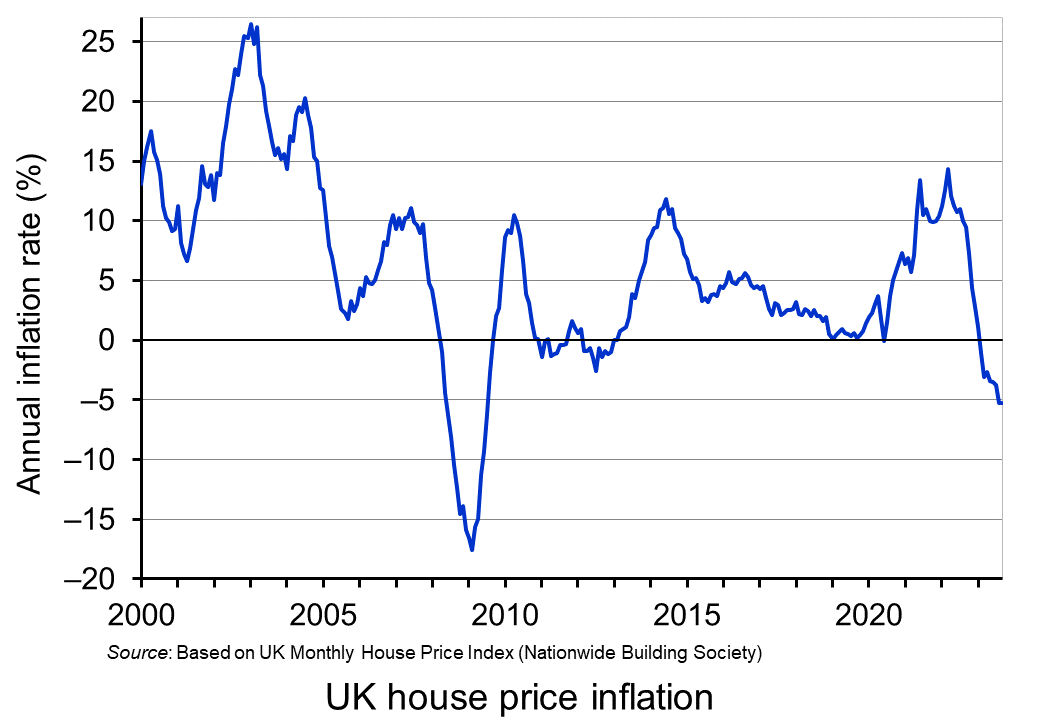 The first is that 74% of borrowers are on fixed-rate mortgages and 96% of new mortgages since 2019 have been at fixed rates. More than half of people with fixed rates have not yet had to renew their mortgage since interest rates began rising in December 2021. These people, therefore, have not yet been affected by the rise in mortgage interest rates.
The first is that 74% of borrowers are on fixed-rate mortgages and 96% of new mortgages since 2019 have been at fixed rates. More than half of people with fixed rates have not yet had to renew their mortgage since interest rates began rising in December 2021. These people, therefore, have not yet been affected by the rise in mortgage interest rates.
The second is that interest rates are expected to peak and then fall. Even though by December 2024 another 2 million households will have had to renew their mortgage, those taking out new longer-term fixed rates may find that rates are lower than those on offer today. This could help to reduce the downward effect on house prices.
The third is that rents continue to rise, partly in response to the higher mortgage rates paid by landlords. With the price of this substitute product rising, this acts as an incentive for existing homeowners not to sell and existing renters to buy, even though they are facing higher mortgage payments.
The fourth is that house prices do not necessarily reflect the overall market equilibrium. People selling may hold out for a better price, hoping that they will eventually attract a buyer. Houses thus are taking longer to sell. This creates a glut of houses at above-equilibrium prices, with fewer sales taking place. At the same time, these higher prices depress demand. People would rather wait for a fall in house prices than pay the current asking price. This creates more of a ‘buyers’ market’, with some sellers being forced to sell well below the asking price. According to Zoopla (see linked article below), the average selling price is 4.2% below the asking price – the highest since 2019. Nevertheless, with sellers holding out and with reduced sales, actual sale prices have fallen less than if markets cleared.
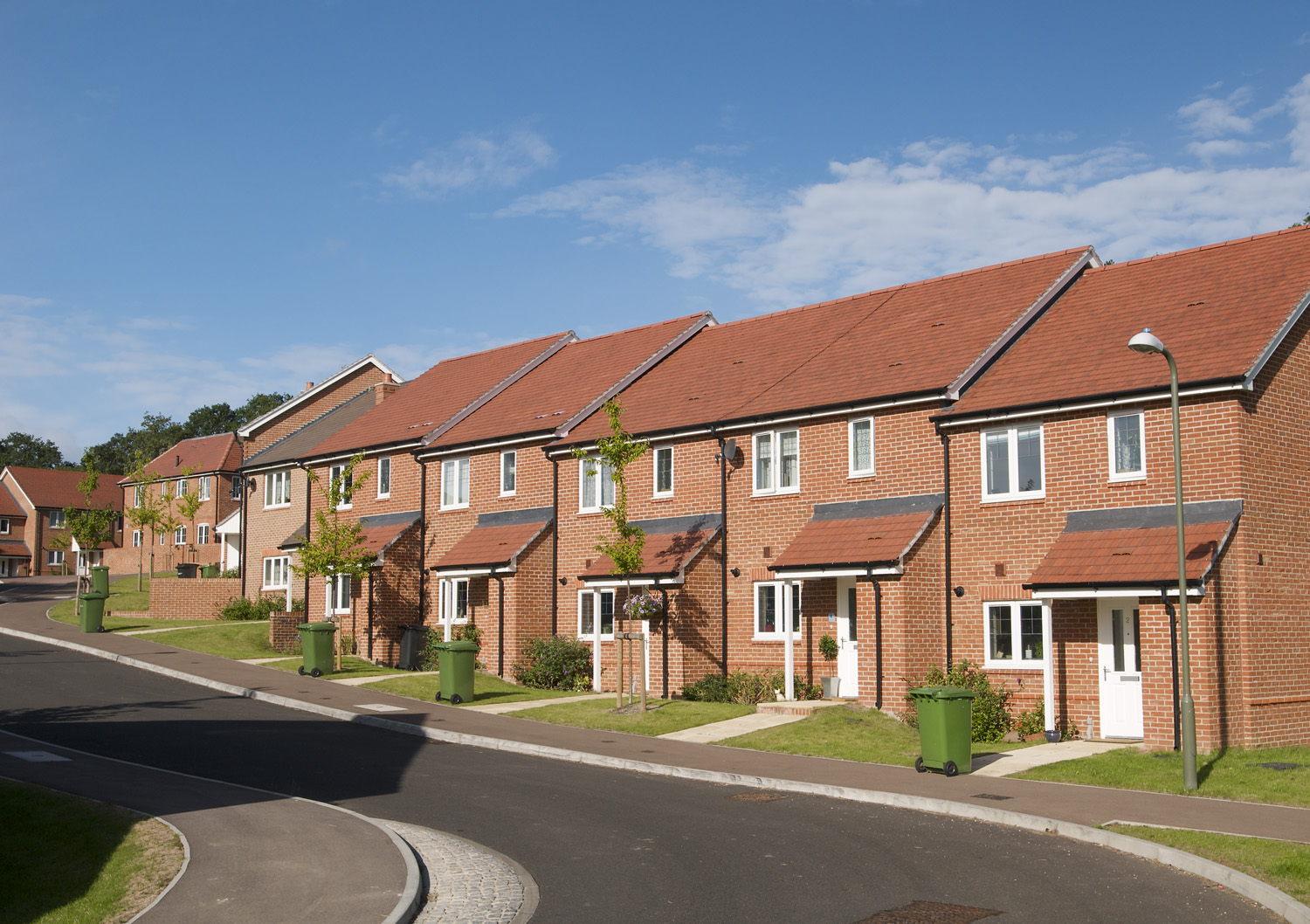 So will house prices continue to fall and will the rate of decline accelerate? This depends on confidence and affordability. With interest rates falling, confidence and affordability are likely to rise. This will help to arrest further price falls.
So will house prices continue to fall and will the rate of decline accelerate? This depends on confidence and affordability. With interest rates falling, confidence and affordability are likely to rise. This will help to arrest further price falls.
However, with large numbers of people still on low fixed rates but with these fixed terms ending over the coming months, for them interest rates will be higher and this could continue to have a dampening effect on demand. What is more, affordability is likely to rise only slowly and in the short term could fall further. Petrol and diesel prices remain high and home energy costs and food prices are still well above the levels of two years ago. Inflation generally is coming down only slowly. The higher prices plus a rising tax burden from fiscal drag1 will continue to squeeze household budgets. This will reduce the size of deposits and the monthly payments that house purchasers can afford.
Over the longer term, house prices are set to rise again. Lower interest rates, rising real incomes again and a failure of house building to keep up with the growth in the number of people seeking to buy houses will all contribute to this. However, over the next few months, house prices are likely to continue falling. But just how much is difficult to predict. A lot will depend on expectations about house prices and incomes, how quickly inflation falls and how quickly the Bank of England reduces interest rates.
1 With tax thresholds frozen, as people’s wages rise, so a higher proportion of their income is taxed and, for higher earners, a higher proportion is taxed at a higher rate. This automatically increases income tax as a proportion of income.
Articles
- House Price Index – September 2023
Zoopla, Richard Donnell (28/9/23)
- UK home sellers increase discounts to secure deals, Zoopla data shows
Financial Times, Joshua Oliver (28/9/23)
- Buyer’s market! House hunters bag £12k off average asking price, says Zoopla
This is Money, Jane Denton (28/9/23)
- House price growth remained weak in September
Nationwide HPI Reports (2/10/23)
- UK mortgage approvals hit six-month low as interest rates cool market
The Guardian, Phillip Inman (29/9/23)
- UK house prices are plummeting at the most rapid pace in over a decade
Euronews, Daniel Harper (2/10/23)
- House prices fall across all UK regions for first time since 2009
Financial Times, Valentina Romei (2/10/23)
- Will house prices fall in 2023?
The Times, Hannah Smith and Georgie Frost (4/10/23)
- First-time buyers in UK drop by a fifth as higher mortgage costs bite
The Guardian, Julia Kollewe (27/9/23)
- England worst place in developed world to find housing, says report
The Guardian, Robert Booth (5/10/23)
- UK homeowners face huge rise in payments when fixed-rate mortgages expire
The Guardian, Richard Partington (17/6/23)
- UK house prices: Where the cheapest areas to buy are, and how far prices could fall
i News, Zesha Saleem (29/9/23)
- Why are house prices falling?
Independent, Vicky Shaw (7/9/23)
Data
Questions
- Use a supply and demand diagram to illustrate the situation where house prices are above the equilibrium.
- Why does house price inflation/deflation differ (a) from one type of house (or flat) to another; (b) from one region of the economy/locality to another?
- Find out why house prices rose so much (a) in the early 2000s; (b) from 2020 to 2022.
- Find out why house prices fell so much from 2008 to 2010. Why was this fall so much greater than in recent months?
- Find out what is happening to house prices in two other developed countries of your choice. How does the current housing market in these countries differ from that in the UK?
- Paint possible scenarios (a) where UK house prices continue to fall by several percentage points; (b) begin to rise again very soon.
 This is the second of three blogs looking at high inflation and its implications. Here we look at changes in the housing market and its effects on households. Another way of analysing the financial importance of the housing and mortgage markets is through the balance sheets and associated flow accounts of the household sector.
This is the second of three blogs looking at high inflation and its implications. Here we look at changes in the housing market and its effects on households. Another way of analysing the financial importance of the housing and mortgage markets is through the balance sheets and associated flow accounts of the household sector.
We used the concept of balance sheets in our blog Bank failures and the importance of balance sheets. In the blog we referred to the balance-sheet effects from interest rate hikes on the financial well-being of financial institutions.
The analysis is analogous for households. Again, we can identify two general effects: rising borrowing and debt-servicing costs, and easing asset prices.
The following table shows the summary balance sheet of the UK household sector in 1995 and 2021.

Source: National balance sheet estimates for the UK: 1995 to 2021 (January 2023) and series RPHA, ONS
The total value of the sector’s net wealth (or ‘worth’) is the sum of its net financial wealth and its non-financial assets. The former is affected by the value of the stock of outstanding mortgages, which we can see from row 3 in the table (‘loans secured on dwellings’) has increased from £390 billion in 1995 to £1.56 trillion in 2021. This is equivalent to an increase from 70 to 107 per cent of the sector’s annual disposable income. This increase helps to understand the sensitivity of the sector’s financial position to interest rate increases and the sizeable cash flow effects. These effects then have implications for the sector’s spending.
 Housing is also an important asset on household balance sheets. The price of housing reflects both the value of dwellings and the land on which they sit, and these are recorded separately on the balance sheets. Their combined balance sheet value increased from £1.09 trillion (£467.69bn + £621.49bn) in 1995 to £6.38 trillion (£1529.87bn + £4853.16bn) in 2021 or from 128% of GDP to 281%.
Housing is also an important asset on household balance sheets. The price of housing reflects both the value of dwellings and the land on which they sit, and these are recorded separately on the balance sheets. Their combined balance sheet value increased from £1.09 trillion (£467.69bn + £621.49bn) in 1995 to £6.38 trillion (£1529.87bn + £4853.16bn) in 2021 or from 128% of GDP to 281%.
The era of low inflation and low interest rates that had characterised the previous two decades or so had helped to boost house price growth and thus the value of non-financial assets on the balance sheets. In turn, this had helped to boost net worth, which increased from £2.78 trillion in 1995 to £12.29 trillion in 2021 or from 319% of GDP to 541%.
Higher interest rates and wealth
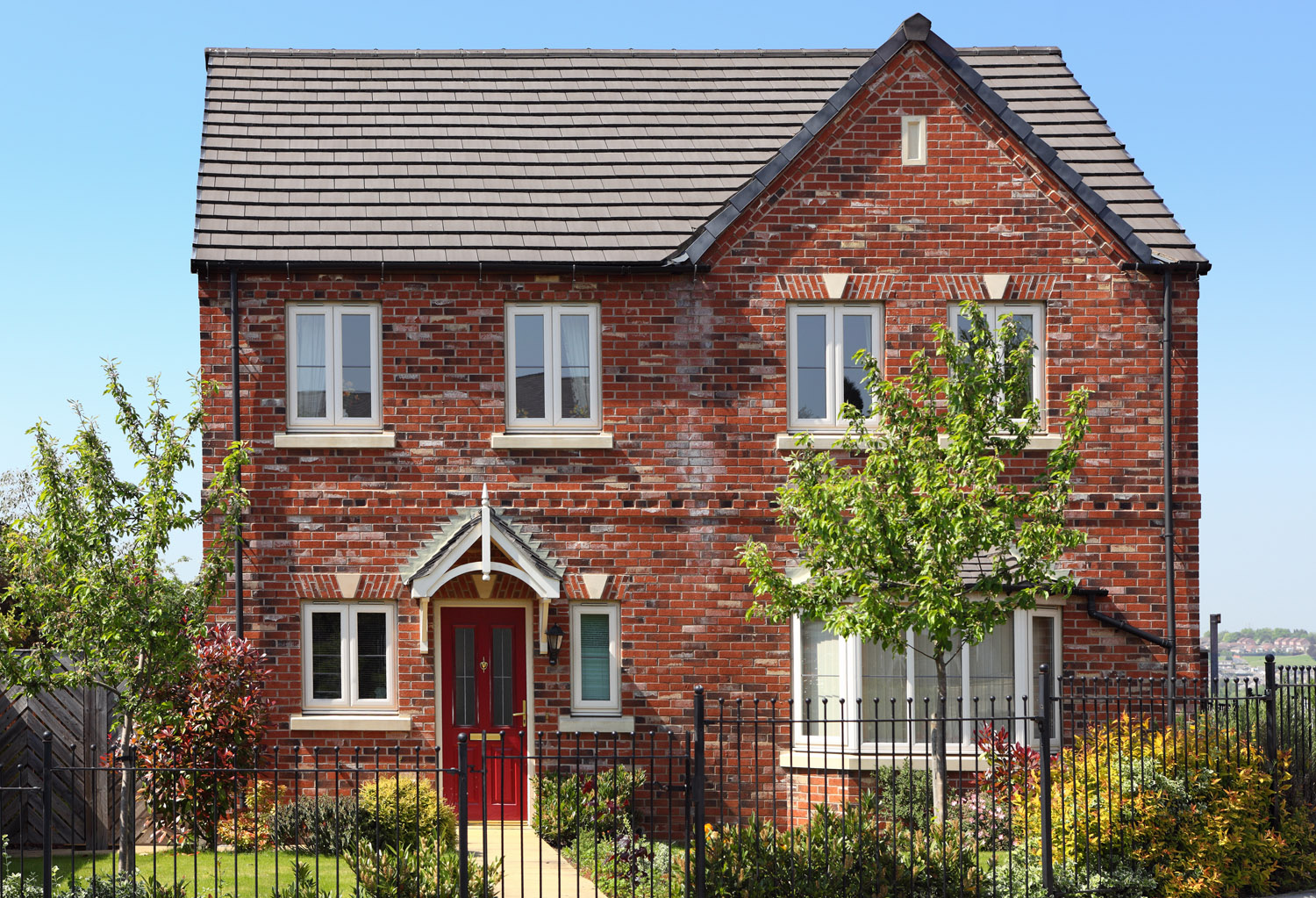 The advent of higher interest rates was expected not only to impact on the debt servicing costs of households but the value of assets, including, in the context of this blog, housing. As Chart 3 in the previous blog helped to show, higher interest rates and higher mortgage repayments contributed to an easing of house price growth as housing demand eased. On the other hand, the impact on mortgaged landlords helped fuel the growth of rental prices as they passed on their increased mortgage repayment costs to tenants.
The advent of higher interest rates was expected not only to impact on the debt servicing costs of households but the value of assets, including, in the context of this blog, housing. As Chart 3 in the previous blog helped to show, higher interest rates and higher mortgage repayments contributed to an easing of house price growth as housing demand eased. On the other hand, the impact on mortgaged landlords helped fuel the growth of rental prices as they passed on their increased mortgage repayment costs to tenants.
Higher interest rates not only affect the value of housing but financial assets such as corporate and government bonds whose prices are inversely related to interest rates. Research published by the Resolution Foundation in July 2023 estimates that these effects are likely to have contributed to a fall in the household wealth from early 2021 to early 2023 by as much as £2.1 trillion.
The important point here is that further downward pressure on asset prices is expected as they adjust to higher interest rates. This and the impact of higher debt servicing costs will therefore continue to impact adversely on general financial well-being with negative implications for the wider macroeconomic environment.
Articles
- The Mortgage Crunch
Resolution Foundation, Simon Pittaway (17/6/23)
- Peaked Interest?
Resolution Foundation, Molly Broome, Ian Mulheirn and Simon Pittaway (17/7/23)
- UK inflation to fall to lowest level since March 2022 but Bank of England still tipped to hike interest rates
City A.M., Jack Barnett (17/7/23)
- Mortgage payments set to jump by £500 for one million households
BBC News, Tom Espiner (13/7/23)
- Interest rates: Big rise less likely after inflation surprise
BBC News, Daniel Thomas, Faisal Islam & Dharshini David (19/7/23)
- Rising Mortgage Costs. What Can Be Done?
NIESR blog, Max Mosley and Adrian Pabst (17/7/23)
- UK interest rates forecast to rise less sharply after inflation falls to 7.9%
The Guardian, Richard Partington (19/7/23)
- Mortgage costs: More Scots falling behind on repayments
Herald Scotland, Kristy Dorsey (18/7/23)
Report
Data
Questions
- What possible indicators could be used to assess the affordability of residential house prices?
- What do you understand by the concept of the monetary policy transmission mechanism? How do the housing and mortgage markets relate to this concept?
- What factors might affect the proportion of people taking out fixed-rate mortgages rather than variable-rate mortgages?
- What is captured by the concept of net worth? Discuss how the housing and mortgage markets affect the household sector’s net worth.
- What are cash-flow effects? How do rising interest rates effect savers and borrowers?
- How might wealth effects from rising interest rates impact younger and older people differently?
- Discuss the ways by which house price changes could affect household consumption.
 This is the first of three blogs looking at inflation, at its effect on household budgets and at monetary policy to bring inflation back to the target rate. This first one takes an overview.
This is the first of three blogs looking at inflation, at its effect on household budgets and at monetary policy to bring inflation back to the target rate. This first one takes an overview.
The housing and mortgage markets are vitally important to the financial well-being of many households. We have seen this vividly in recent times through the impact of rising inflation rates on interest rates and, in turn, on mortgage repayments. Some people on variable rate mortgages, or whose fixed rate deals are coming to the end of their term, have struggled to pay the new higher rates. In this blog we explore the reasons behind these events and the extent to which the financial well-being of UK households has been affected.
Chart 1 shows the path of inflation in the UK since 1997 when the Bank of England’s Monetary Policy Committee (MPC) was first charged with meeting an inflation rate target (click here for a PowerPoint). It captures the impact of the inflation shock that began to emerge in 2021 and saw the CPI inflation rate peak at 11.1 per cent in October 2022 – considerably above the Bank’s 2 per cent target.
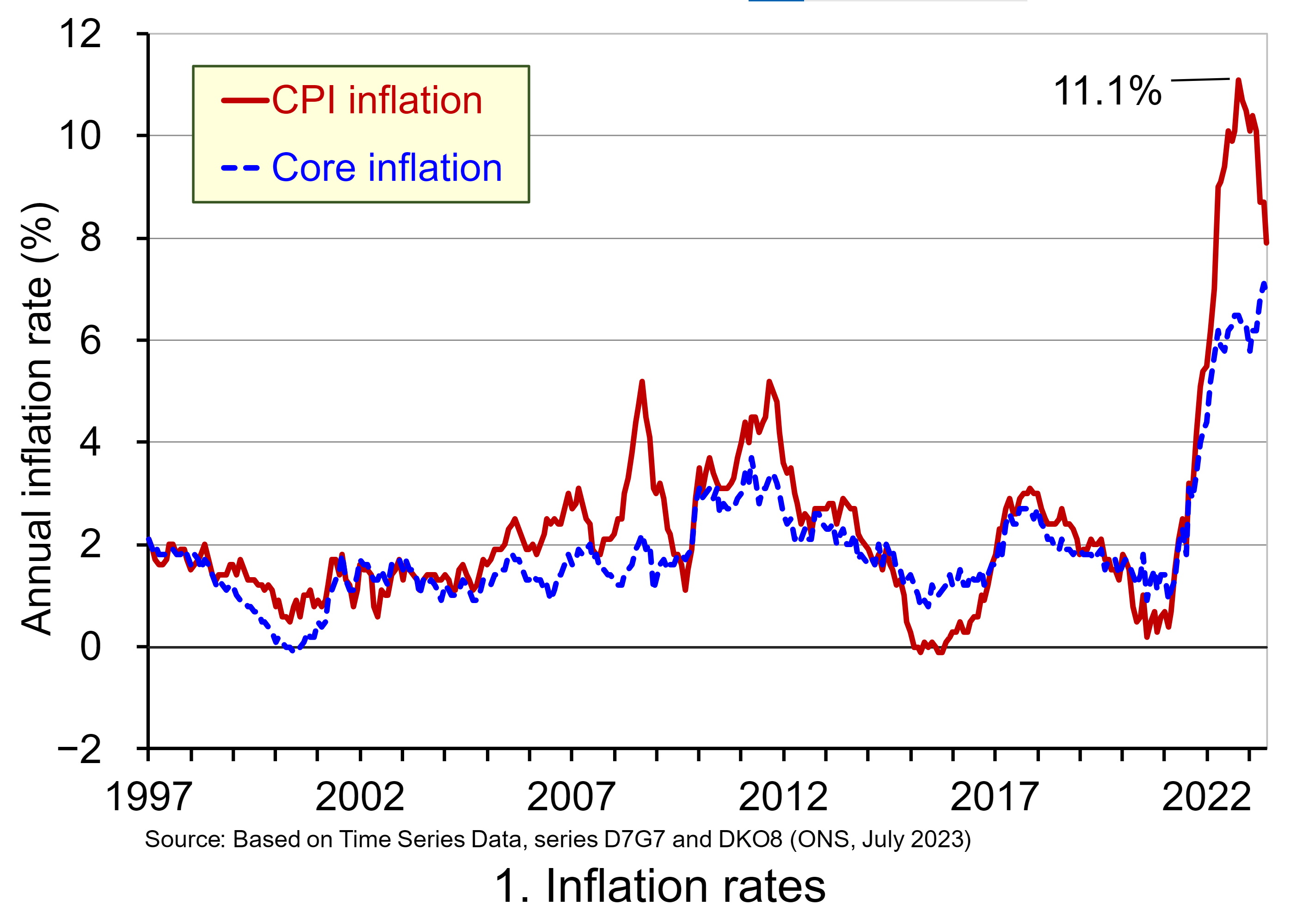 Despite easing somewhat, the CPI inflation rate is showing signs of persistence – meaning that it is taking time for it to return to target. One way of understanding this persistence is to look at a measure of inflation known as core inflation. This inflation rate measure excludes energy, food, alcoholic beverages and tobacco prices, all of which are notoriously volatile. Core inflation thus captures underlying inflationary pressures.
Despite easing somewhat, the CPI inflation rate is showing signs of persistence – meaning that it is taking time for it to return to target. One way of understanding this persistence is to look at a measure of inflation known as core inflation. This inflation rate measure excludes energy, food, alcoholic beverages and tobacco prices, all of which are notoriously volatile. Core inflation thus captures underlying inflationary pressures.
To address the inflationary pressures, the Bank of England began raising Bank Rate in December 2021 from a low of just 0.1 per cent. By June 2023 the Bank Rate had risen to 5 per cent with the prospect of further hikes. As the Bank Rate rises, the cost of borrowing from the Bank of England by commercial banks rises too. Therefore increases in the Bank Rate ripple through to other interest rates. However, the passthrough effect can be uneven affecting spreads between Bank Rate and other interest rates.
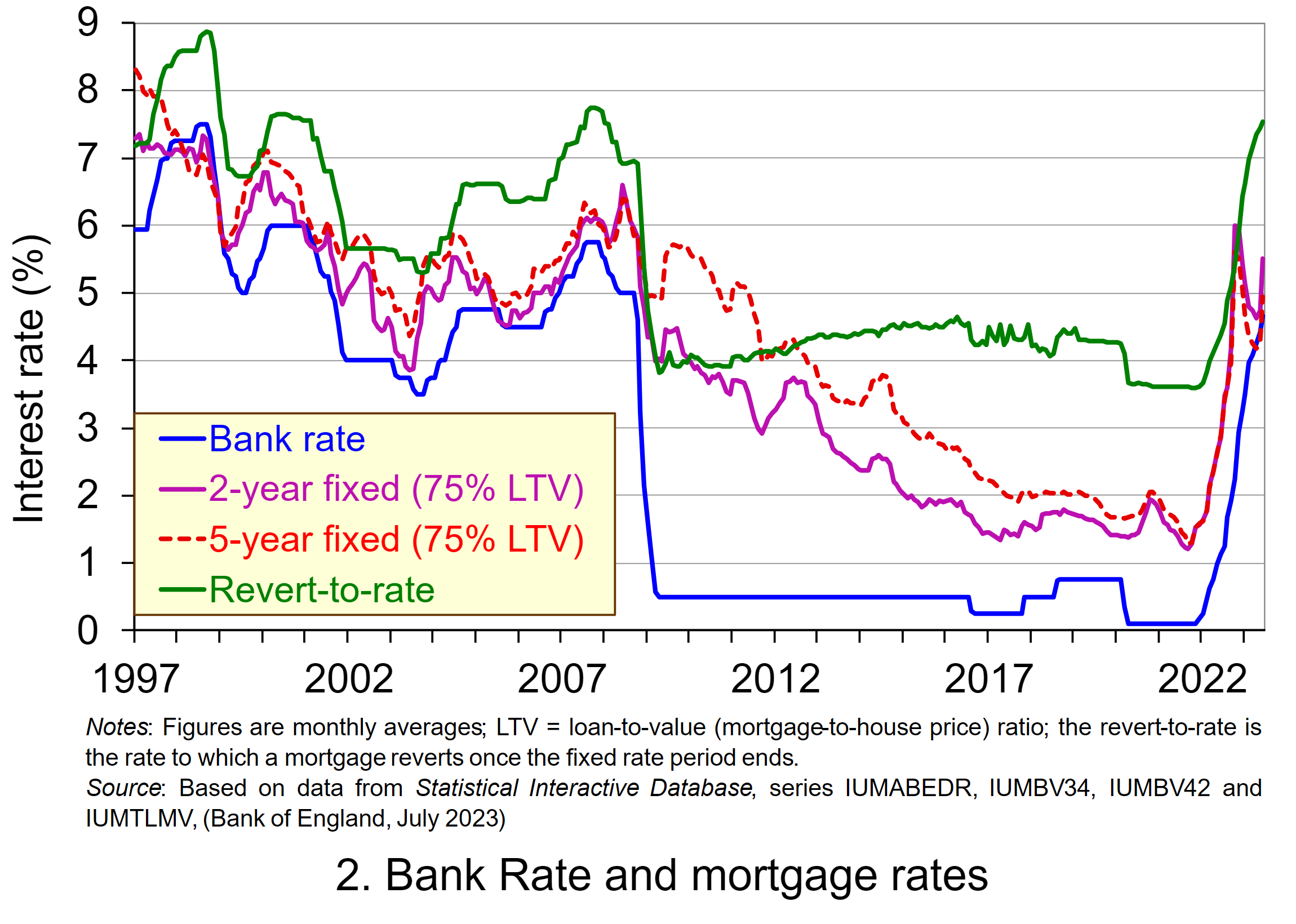 The increase in the Bank Rate is reflected in the increases in mortgage rates shown in Chart 2 (click here for a PowerPoint). As we have seen, this affects most immediately those with variable rate mortgages, and then those with fixed-rate mortgages as they come up for renewal. Analysis from the Resolution Foundation (2023) estimates that 4.2 million households saw their mortgage rates change between December 2021 and June 2023 – the equivalent of 56 per cent of mortgaged households.
The increase in the Bank Rate is reflected in the increases in mortgage rates shown in Chart 2 (click here for a PowerPoint). As we have seen, this affects most immediately those with variable rate mortgages, and then those with fixed-rate mortgages as they come up for renewal. Analysis from the Resolution Foundation (2023) estimates that 4.2 million households saw their mortgage rates change between December 2021 and June 2023 – the equivalent of 56 per cent of mortgaged households.
The persistence of inflation means that mortgage rates may not have yet peaked and are likely to stay higher for longer than originally thought. With fixes normally between two to five years, the problem of higher rates for those renewing will continue. The Resolution Foundation projects that by the end of 2026, almost all households with a mortgage would have moved to a higher rate since December 2021. At this point, the typical annual repayment cost for mortgaged households is forecast to be £2000 per annum higher, leading to an increase in annual repayments for the UK household sector of £15.8 billion.
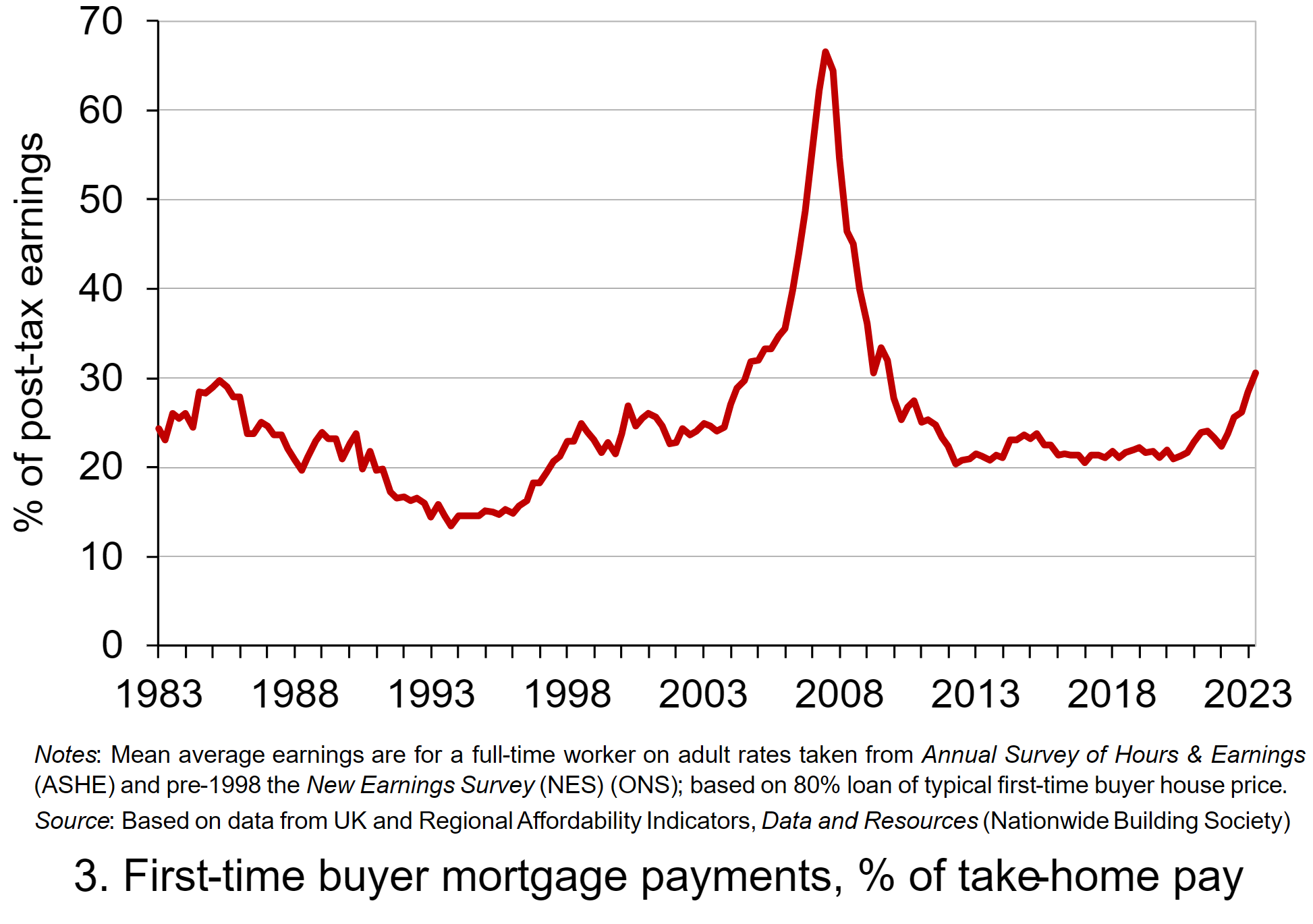 Chart 3 provides a visual picture of the typical annual repayment costs facing first-time buyers as a percentage of earnings after tax and national insurance (click here for a PowerPoint). The Nationwide Building Society figures are based on an 80% loan on the typical first-time buyer house price. It shows that repayment costs have been rising sharply on the back of rising interest rates and are now higher than at any time since the global financial crisis of 2007–8.
Chart 3 provides a visual picture of the typical annual repayment costs facing first-time buyers as a percentage of earnings after tax and national insurance (click here for a PowerPoint). The Nationwide Building Society figures are based on an 80% loan on the typical first-time buyer house price. It shows that repayment costs have been rising sharply on the back of rising interest rates and are now higher than at any time since the global financial crisis of 2007–8.
Articles
- UK inflation to fall to lowest level since March 2022 but Bank of England still tipped to hike interest rates
City A.M., Jack Barnett (17/7/23)
- UK inflation and interest rates high – how do other economies compare?
BBC News, Dharshini David (23/7/23)
- Mortgage payments set to jump by £500 for one million households
BBC News, Tom Espiner (13/7/23)
- Interest rates: Big rise less likely after inflation surprise
BBC News, Daniel Thomas, Faisal Islam & Dharshini David (19/7/23)
- Rising Mortgage Costs. What Can Be Done?
NIESR blog, Max Mosley and Adrian Pabst (17/7/23)
- UK interest rates forecast to rise less sharply after inflation falls to 7.9%
The Guardian, Richard Partington (19/7/23)
- Mortgage costs: More Scots falling behind on repayments
Herald Scotland, Kristy Dorsey (18/7/23)
- The Mortgage Crunch
Resolution Foundation, Simon Pittaway (17/6/23)
- Peaked Interest?
Resolution Foundation, Molly Broome, Ian Mulheirn and Simon Pittaway (17/7/23)
Data
Questions
- What possible indicators could be used to assess the affordability of residential house prices?
- What is captured by the rate of core inflation? Discuss the arguments for using this as the target inflation rate measure.
- What factors might affect the proportion of people taking out fixed-rate mortgages rather than variable-rate mortgages?
- Discuss the ways by which house price changes could impact on household consumption.
- Investigate the proportion of mortgages that are fixed rate and the typical length of the fixed rate term in two European countries, the USA and Japan. How does each differ from the UK?
On 3 November, the Bank of England announced the highest interest rate rise in 33 years. It warned that the UK is facing the longest recession since records began. With the downturn starting earlier than expected and predicted to last for longer, households, businesses and the government are braced for a challenging few years ahead.
Interest rates
 The Monetary Policy Committee increased Bank Rate to 3% from the previous rate of 2.25%. This 75-basis point increase is the largest since 1989 and is the eighth rise since December. What is more, the Bank has warned that it will not stop there. These increases in interest rates are there to try to tackle inflation, which rose to 10.1% in September and is expected to be 11% for the final quarter of this year. Soaring prices are a growing concern for UK households, with the cost of living rising at the fastest rate for 40 years. It is feared that such increases in the Bank’s base rate will only worsen household circumstances.
The Monetary Policy Committee increased Bank Rate to 3% from the previous rate of 2.25%. This 75-basis point increase is the largest since 1989 and is the eighth rise since December. What is more, the Bank has warned that it will not stop there. These increases in interest rates are there to try to tackle inflation, which rose to 10.1% in September and is expected to be 11% for the final quarter of this year. Soaring prices are a growing concern for UK households, with the cost of living rising at the fastest rate for 40 years. It is feared that such increases in the Bank’s base rate will only worsen household circumstances.
There are various causes of the current cost-of-living crisis. These include the pandemic’s effect on production, the aftermath in terms of supply-chain problems and labour shortages, the war in Ukraine and its effect on energy and food prices, and poor harvests in many parts of the world, including many European countries. It has been reported that grocery prices in October were 4.7% higher than in October 2021. This is the highest rate of food price inflation on record and means shoppers could face paying an extra £682 per year on average.
There is real concern about the impact of the interest rates rise on the overall economy but, in particular, on peoples’ mortgages. Bank of England Governor, Andrew Bailey, warned of a ‘tough road ahead’ for UK households, but said that the MPC had to act forcefully now or things ‘will be worse later on’.
However, it could be argued that there was a silver lining in Thursday’s announcement. The future rises in interest rates are predicted to peak at a lower rate than previously thought. Amongst all the mini-budget chaos, there was concern that rates could surpass the 6% mark. Now the Bank of England has given the assurance that future rate rises will be limited and that Bank Rate should not increase beyond 5% by next autumn. The Bank was keen to reassure markets of this by making clear the thinking behind the decision in the published minutes of MPC meeting.
Recession
 With the Bank warning of the longest recession since records began, what does this actually mean? Economies experience periods of growth and periods of slowdown or even decline in real GDP. However, a recession is defined as when a country’s economy shrinks for two three-month periods (quarters) in a row. The last time the UK experienced a recession was in 2020 during the height of the pandemic. During a recession, businesses typically make less profits, pay falls, some people may lose their jobs and unemployment rises. This means that the government receives less money in taxation to use on public services such as health and education. Graduates and school leavers could find it harder to get their first job, while others may find it harder to be promoted or to get big enough pay rises to keep pace with price increases. However, the pain of a recession is typically not felt equally across society, and inequality can increase.
With the Bank warning of the longest recession since records began, what does this actually mean? Economies experience periods of growth and periods of slowdown or even decline in real GDP. However, a recession is defined as when a country’s economy shrinks for two three-month periods (quarters) in a row. The last time the UK experienced a recession was in 2020 during the height of the pandemic. During a recession, businesses typically make less profits, pay falls, some people may lose their jobs and unemployment rises. This means that the government receives less money in taxation to use on public services such as health and education. Graduates and school leavers could find it harder to get their first job, while others may find it harder to be promoted or to get big enough pay rises to keep pace with price increases. However, the pain of a recession is typically not felt equally across society, and inequality can increase.
The Bank had previously expected the UK to fall into recession at the end of this year but the latest data from the Office for National Statistics (ONS) show that GDP fell by 0.3% in the three months to August. The Bank is predicting that GDP will shrink by 0.5% between May and August 2023, followed by a further fall of 0.3% between September and December. The Bank then expects the UK economy to remain in recession throughout 2023 and the first half of 2024.
With the higher interest rates, borrowing costs are now at their highest since 2008, when the UK banking system faced collapse in the wake of the global financial crisis. The Bank believes that by raising interest rates it will make it more expensive to borrow and encourage people not to spend money, easing the pressure on prices in the process. It does, however, mean that savers will start to benefit from higher rates (but still negative real rates), but it will have a knock-on effect on those with mortgages, credit card debt and bank loans.
The recession in 2020 only lasted for six months, although the 20.4% reduction in the UK economy between April and June that year was the largest on record. The one before that started in 2008 with the global financial crisis and went on for five quarters. Whilst it will not be the UK’s deepest downturn, the Bank stressed that it will be the longest since records began in the 1920s.
Mortgages
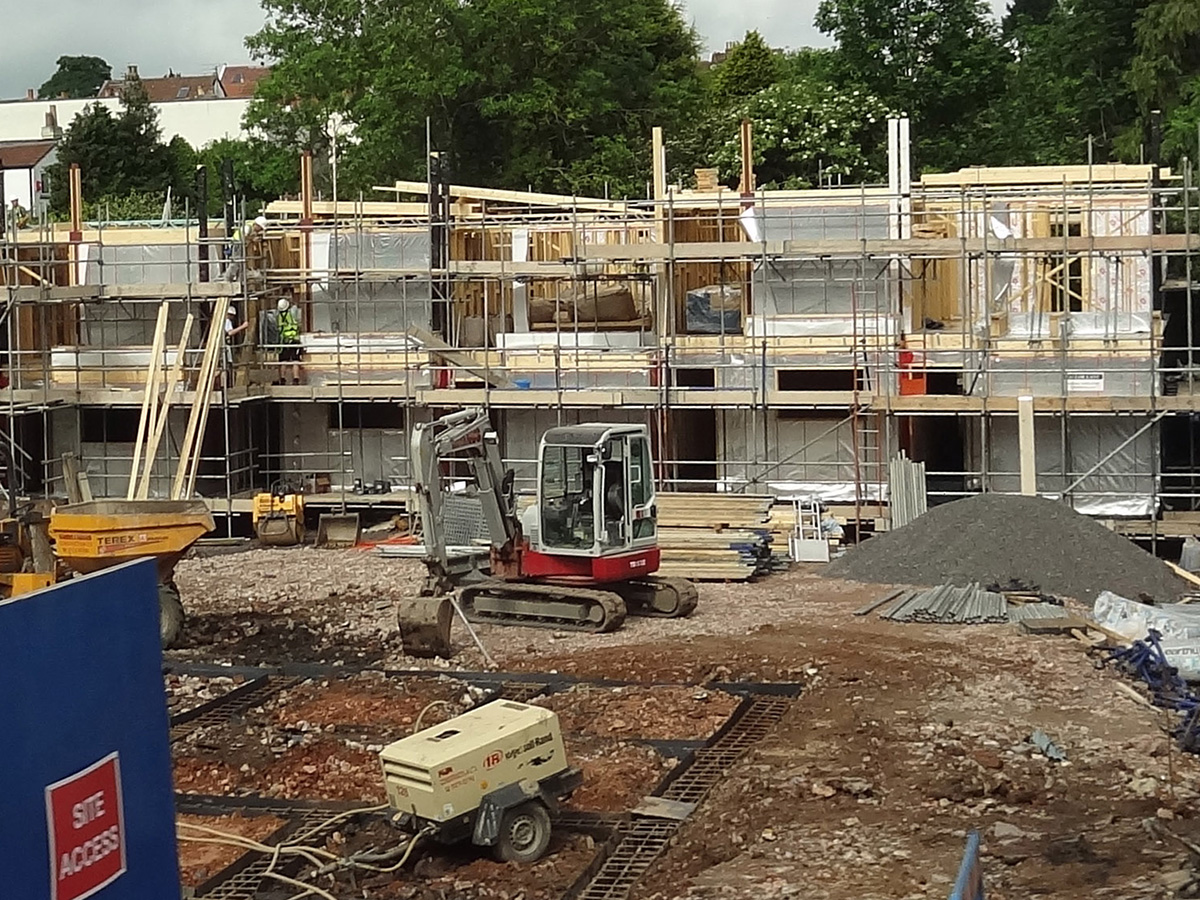 Those with mortgages are rightly feeling nervous about the impact that further increases in mortgage interest rates will have on their budgets. Variable mortgage rates and new fixed rates have been rising for several months because of this year’s run of rate rises but they shot up after the mini-Budget. The Bank forecasts that if interest rates continue to rise, those whose fixed rate deals are coming to an end could see their annual payments soar by an average of £3000.
Those with mortgages are rightly feeling nervous about the impact that further increases in mortgage interest rates will have on their budgets. Variable mortgage rates and new fixed rates have been rising for several months because of this year’s run of rate rises but they shot up after the mini-Budget. The Bank forecasts that if interest rates continue to rise, those whose fixed rate deals are coming to an end could see their annual payments soar by an average of £3000.
Homebuyers with tracker or variable rate mortgages will feel the pain of the rate rise immediately, while the estimated 300 000 people who must re-mortgage this month will find that two-year and five-year fixed rates remain at levels not seen since the 2008 financial crisis. However, the Bank said that the cost of fixed-rate mortgages had already come down from the levels seen at the height of the panic in the wake of Kwasi Kwarteng’s mini-Budget, which sent them soaring above 6%.
There is a fear of the devastating impact on those who simply cannot afford further increases in payments. The Joseph Rowntree Foundation (JRF) said an extra 120 000 households in the UK, the equivalent of 400 000 people, will be plunged into poverty when their current mortgage deal ends. The analysis assumes that mortgage rates remain high, with homeowners forced to move to an interest rate of around 5.5%. For people currently on fixed rates typically of around of 2% which are due to expire, this change would mean a huge increase. Such people, on average, would find the proportion of their monthly income going on housing costs rising from 38% to 54%. In cash terms this equates to an average increase of £250, from £610 a month to £860 a month.
In addition to these higher monthly home-loan costs threatening to pull another 400 000 people into poverty, such turmoil in the mortgage market would increase competition for rental properties and could result in rents for new lets rising sharply as the extra demand allows buy-to-let landlords to pass on their higher loan costs (or more).
Unemployment
Since the mini-Budget, the level of the pound and government borrowing costs have somewhat recovered. However, mortgage markets and business loans are still showing signs of stress, adding to the prolonged hit to the economy. The Bank now forecasts that the unemployment rate will rise, while household incomes will come down too. The unemployment rate is currently at its lowest for 50 years, but it is expected to rise to nearly 6.5%.
Looking to the future
 It is the case that the lasting effects of the pandemic, the war in Ukraine and the energy shock have all played their part in the current economic climate. However, it could be argued that the Bank and the government are now making decisions that will inflict further pain and sacrifice for millions of households, who are already facing multi-thousand-pound increases in mortgage, energy and food bills.
It is the case that the lasting effects of the pandemic, the war in Ukraine and the energy shock have all played their part in the current economic climate. However, it could be argued that the Bank and the government are now making decisions that will inflict further pain and sacrifice for millions of households, who are already facing multi-thousand-pound increases in mortgage, energy and food bills.
There have been further concerns raised about the possible tax rises planned by the Chancellor Jeremy Hunt. If large tax rises and spending cuts are set out in the Autumn Statement of 17 November, the Bank of England’s chief economist has warned that Britain risks a deeper than expected economic slowdown. This could weigh on the British economy by more than the central bank currently anticipates, in a development that would force it to rethink its approach to setting interest rates.
There is no doubt that the future economic picture looks painful, with the UK performing worse than the USA and the eurozone. The Bank Governor, Andrew Bailey, believes that the mini-Budget had damaged the UK’s reputation internationally, stating, ‘it was very apparent to me that the UK’s position and the UK’s standing had been damaged’. However, both the Governor and the Chancellor or the Exchequer agree that action needs to be taken now in order for the economy to stabilise long term.
Jeremey Hunt, the Chancellor, explained that the most important thing the British government can do right now is to restore stability, sort out the public finances and get debt falling so that interest rate rises are kept as low as possible. This echoes the Bank’s belief in the importance of acting forcefully now in order to prevent things being much worse later on. With the recession predicted to last into 2024, the same year as a possible general election, the Conservatives face campaigning to remain in government at the tail end of a prolonged slump.
Report
Articles
- Bank of England expects UK to fall into longest ever recession
BBC News, Dearbail Jordan & Daniel Thomas (4/11/22)
- What is a recession and how could it affect me?
BBC News (3/11/22)
- Is it right to raise interest rates in a recession?
BBC News, Faisal Islam (4/11/22)
- Rising interest rates: why the Bank of England has increased rates again and what to expect next
The Conversation, Francesc Rodriguez-Tous (7/11/22)
- Bank of England raises interest rates by 0.75 percentage points
Financial Times, Chris Giles and Delphine Strauss (3/11/22)
- Bank of England raises its benchmark rate by 75 basis points, its biggest hike in 33 years
CNBC, Elliot Smith (3/11/22)
- Interest rate rises to 3% as Bank of England imposes biggest hike for three decades
Sky News, Ed Conway (3/11/22)
 Interest Rates: What’s behind the rise?
Interest Rates: What’s behind the rise?Sky News on YouTube, Paul Kelso (3/11/22)
- Falls in UK mortgage rates predicted as BoE signals dovish outlook
Financial Times, James Pickford and Siddharth Venkataramakrishnan (3/11/22)
- BoE outlines two bleak scenarios for taming inflation
Financial Times, Chris Giles (3/11/22)
- Bank of England warns of longest recession in 100 years as it raises rates to 3%
The Guardian, Larry Elliott and Phillip Inman (3/11/22)
- UK mortgage rate rises ‘will put extra 400,000 people in poverty’
The Guardian, Zoe Wood (4/11/22)
- Large tax rises from Jeremy Hunt ‘could put UK at risk of deeper slowdown’
The Guardian, Richard Partington (7/11/22)
- Bank of England will raise interest rates again, says chief economist
The Guardian, Richard Partington (8/11/22)
Questions
- Define the term ‘recession’ and how is it measured.
- Explain what happens to the key macroeconomic indicators during this period of the business cycle.
- Which policies would governments normally implement to get a economy into the
- expansionary/recovery phase of the business cycle and how do they work?
- What is the issue of raising interest rates during a downturn or recession?
- With unemployment expected to rise, explain what type of unemployment this is. What policies could be introduced to reduce this type of unemployment?
 When I worked as a professional economist at HM Treasury and later the Council of Mortgage Lenders (now part of UK Finance), I would regularly brief on the state of the affordability of housing, with a particular focus on the owner-occupied market. That was back in the late 1990s. Fast forward a quarter of a century and I recognise not only how much I have aged but also how deep-rooted and long-standing the affordability problem is.
When I worked as a professional economist at HM Treasury and later the Council of Mortgage Lenders (now part of UK Finance), I would regularly brief on the state of the affordability of housing, with a particular focus on the owner-occupied market. That was back in the late 1990s. Fast forward a quarter of a century and I recognise not only how much I have aged but also how deep-rooted and long-standing the affordability problem is. The average UK actual or nominal house price in April 2024 was £281 000. As Chart 1 shows, this masks considerable differences across the UK. In England the average price was £298 000 (105 per cent of the UK average), though this is heavily skewed by London where the average price was £502 000 (178 per cent of the UK average). Meanwhile, in Scotland it was £190 000 (68 per cent of the UK average), in Wales £208 000 (74 per cent of the UK average) and in Northern Ireland it was £178 000 (74 per cent of the UK average). (Click here to download a PowerPoint copy of the chart.)
The average UK actual or nominal house price in April 2024 was £281 000. As Chart 1 shows, this masks considerable differences across the UK. In England the average price was £298 000 (105 per cent of the UK average), though this is heavily skewed by London where the average price was £502 000 (178 per cent of the UK average). Meanwhile, in Scotland it was £190 000 (68 per cent of the UK average), in Wales £208 000 (74 per cent of the UK average) and in Northern Ireland it was £178 000 (74 per cent of the UK average). (Click here to download a PowerPoint copy of the chart.) Whilst nominal prices trend upwards over time, the short-term rates of increase are highly volatile. This can be seen from an inspection of Chart 2, which shows the annual rates of increase across the four nations of the UK, as well as for London. This is evidence of frequent imbalances between the flows of property on to the market to sell (instructions to sell) and the number of people looking to buy (instructions to buy). An increase in instructions to buy (housing demand) relative to those to sell (housing supply) puts upward pressure on prices; an increase in the number of instructions to sell (housing supply) relative to those to buy (housing demand) puts downward pressure on prices. (Click here to download a PowerPoint copy of the chart.)
Whilst nominal prices trend upwards over time, the short-term rates of increase are highly volatile. This can be seen from an inspection of Chart 2, which shows the annual rates of increase across the four nations of the UK, as well as for London. This is evidence of frequent imbalances between the flows of property on to the market to sell (instructions to sell) and the number of people looking to buy (instructions to buy). An increase in instructions to buy (housing demand) relative to those to sell (housing supply) puts upward pressure on prices; an increase in the number of instructions to sell (housing supply) relative to those to buy (housing demand) puts downward pressure on prices. (Click here to download a PowerPoint copy of the chart.) To calculate real or inflation-adjusted house prices, we deflate nominal house prices by the Consumer Prices Index (CPI). Chart 3 shows the resulting real house prices series across the UK as if consumer prices were fixed at 2015 levels.
To calculate real or inflation-adjusted house prices, we deflate nominal house prices by the Consumer Prices Index (CPI). Chart 3 shows the resulting real house prices series across the UK as if consumer prices were fixed at 2015 levels. Chart 4 shows how the volatility in house prices continues to be evident when house prices are adjusted for changes in consumer prices. The UK’s annual rate of real house price inflation was as high as 40 per in January 1973; on the other hand, in June 1975 inflation-adjusted house prices were 15 per cent lower than a year earlier. (Click here to download a PowerPoint copy of the chart.)
Chart 4 shows how the volatility in house prices continues to be evident when house prices are adjusted for changes in consumer prices. The UK’s annual rate of real house price inflation was as high as 40 per in January 1973; on the other hand, in June 1975 inflation-adjusted house prices were 15 per cent lower than a year earlier. (Click here to download a PowerPoint copy of the chart.) The newly elected Labour government has made the argument that it needs to prioritise planning reform as an engine for economic growth. While this ambition extends beyond housing, the scale of the supply-side problem facing the housing market can be seen in Chart 5. The chart shows the number of housing completions in the UK since 1950 by type of tenure. (Click here to download a PowerPoint copy of the chart.)
The newly elected Labour government has made the argument that it needs to prioritise planning reform as an engine for economic growth. While this ambition extends beyond housing, the scale of the supply-side problem facing the housing market can be seen in Chart 5. The chart shows the number of housing completions in the UK since 1950 by type of tenure. (Click here to download a PowerPoint copy of the chart.) The first is that 74% of borrowers are on fixed-rate mortgages and 96% of new mortgages since 2019 have been at fixed rates. More than half of people with fixed rates have not yet had to renew their mortgage since interest rates began rising in December 2021. These people, therefore, have not yet been affected by the rise in mortgage interest rates.
The first is that 74% of borrowers are on fixed-rate mortgages and 96% of new mortgages since 2019 have been at fixed rates. More than half of people with fixed rates have not yet had to renew their mortgage since interest rates began rising in December 2021. These people, therefore, have not yet been affected by the rise in mortgage interest rates.  So will house prices continue to fall and will the rate of decline accelerate? This depends on confidence and affordability. With interest rates falling, confidence and affordability are likely to rise. This will help to arrest further price falls.
So will house prices continue to fall and will the rate of decline accelerate? This depends on confidence and affordability. With interest rates falling, confidence and affordability are likely to rise. This will help to arrest further price falls.
 The advent of higher interest rates was expected not only to impact on the debt servicing costs of households but the value of assets, including, in the context of this blog, housing. As Chart 3 in the
The advent of higher interest rates was expected not only to impact on the debt servicing costs of households but the value of assets, including, in the context of this blog, housing. As Chart 3 in the  This is the first of three blogs looking at inflation, at its effect on household budgets and at monetary policy to bring inflation back to the target rate. This first one takes an overview.
This is the first of three blogs looking at inflation, at its effect on household budgets and at monetary policy to bring inflation back to the target rate. This first one takes an overview.  Despite easing somewhat, the CPI inflation rate is showing signs of persistence – meaning that it is taking time for it to return to target. One way of understanding this persistence is to look at a measure of inflation known as core inflation. This inflation rate measure excludes energy, food, alcoholic beverages and tobacco prices, all of which are notoriously volatile. Core inflation thus captures underlying inflationary pressures.
Despite easing somewhat, the CPI inflation rate is showing signs of persistence – meaning that it is taking time for it to return to target. One way of understanding this persistence is to look at a measure of inflation known as core inflation. This inflation rate measure excludes energy, food, alcoholic beverages and tobacco prices, all of which are notoriously volatile. Core inflation thus captures underlying inflationary pressures. The increase in the Bank Rate is reflected in the increases in mortgage rates shown in Chart 2 (click
The increase in the Bank Rate is reflected in the increases in mortgage rates shown in Chart 2 (click  Chart 3 provides a visual picture of the typical annual repayment costs facing first-time buyers as a percentage of earnings after tax and national insurance (click
Chart 3 provides a visual picture of the typical annual repayment costs facing first-time buyers as a percentage of earnings after tax and national insurance (click  The Monetary Policy Committee increased Bank Rate to 3% from the previous rate of 2.25%. This 75-basis point increase is the largest since 1989 and is the eighth rise since December. What is more, the Bank has warned that it will not stop there. These increases in interest rates are there to try to tackle inflation, which rose to 10.1% in September and is expected to be 11% for the final quarter of this year. Soaring prices are a growing concern for UK households, with the cost of living rising at the fastest rate for 40 years. It is feared that such increases in the Bank’s base rate will only worsen household circumstances.
The Monetary Policy Committee increased Bank Rate to 3% from the previous rate of 2.25%. This 75-basis point increase is the largest since 1989 and is the eighth rise since December. What is more, the Bank has warned that it will not stop there. These increases in interest rates are there to try to tackle inflation, which rose to 10.1% in September and is expected to be 11% for the final quarter of this year. Soaring prices are a growing concern for UK households, with the cost of living rising at the fastest rate for 40 years. It is feared that such increases in the Bank’s base rate will only worsen household circumstances. With the Bank warning of the longest recession since records began, what does this actually mean? Economies experience periods of growth and periods of slowdown or even decline in real GDP. However, a recession is defined as when a country’s economy shrinks for two three-month periods (quarters) in a row. The last time the UK experienced a recession was in 2020 during the height of the pandemic. During a recession, businesses typically make less profits, pay falls, some people may lose their jobs and unemployment rises. This means that the government receives less money in taxation to use on public services such as health and education. Graduates and school leavers could find it harder to get their first job, while others may find it harder to be promoted or to get big enough pay rises to keep pace with price increases. However, the pain of a recession is typically not felt equally across society, and inequality can increase.
With the Bank warning of the longest recession since records began, what does this actually mean? Economies experience periods of growth and periods of slowdown or even decline in real GDP. However, a recession is defined as when a country’s economy shrinks for two three-month periods (quarters) in a row. The last time the UK experienced a recession was in 2020 during the height of the pandemic. During a recession, businesses typically make less profits, pay falls, some people may lose their jobs and unemployment rises. This means that the government receives less money in taxation to use on public services such as health and education. Graduates and school leavers could find it harder to get their first job, while others may find it harder to be promoted or to get big enough pay rises to keep pace with price increases. However, the pain of a recession is typically not felt equally across society, and inequality can increase. Those with mortgages are rightly feeling nervous about the impact that further increases in mortgage interest rates will have on their budgets. Variable mortgage rates and new fixed rates have been rising for several months because of this year’s run of rate rises but they shot up after the
Those with mortgages are rightly feeling nervous about the impact that further increases in mortgage interest rates will have on their budgets. Variable mortgage rates and new fixed rates have been rising for several months because of this year’s run of rate rises but they shot up after the  It is the case that the lasting effects of the pandemic, the war in Ukraine and the energy shock have all played their part in the current economic climate. However, it could be argued that the Bank and the government are now making decisions that will inflict further pain and sacrifice for millions of households, who are already facing multi-thousand-pound increases in mortgage, energy and food bills.
It is the case that the lasting effects of the pandemic, the war in Ukraine and the energy shock have all played their part in the current economic climate. However, it could be argued that the Bank and the government are now making decisions that will inflict further pain and sacrifice for millions of households, who are already facing multi-thousand-pound increases in mortgage, energy and food bills.